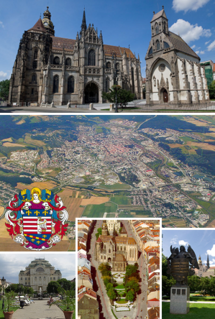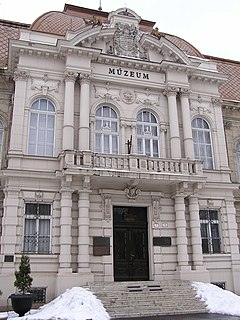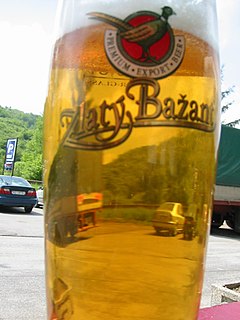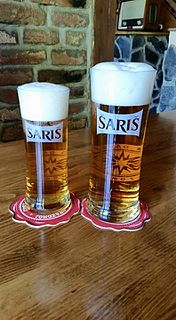
Košice is the largest city in eastern Slovakia. It is situated on the river Hornád at the eastern reaches of the Slovak Ore Mountains, near the border with Hungary. With a population of approximately 240,000, Košice is the second-largest city in Slovakia, after the capital Bratislava.

Levoča is a town in the Prešov Region of eastern Slovakia with a population of 14,700. The town has a historic center with a well preserved town wall, a Gothic church with the highest wooden altar in the world, carved by Master Pavol of Levoča, and many other Renaissance buildings.

Since 1949, Slovakia has been divided into a number of kraje. Their number, borders and functions have been changed several times. There are currently eight regions of Slovakia and they correspond to the EU's NUTS 3 level of local administrative units. Each kraj consists of okresy. There are currently 79 districts.

Prešov is a city in Eastern Slovakia. It is a seat of the administrative Prešov Region and Šariš as well as the historic Sáros County of the Kingdom of Hungary. With a population of approximately 90,000 for the city, and in total about 110,000 in the metropolitan area, it is the third-largest city in Slovakia. It lends its name to the Eperjes-Tokaj Hill-Chain which was considered as the geographic entity on the first map of Hungary from 1528. There are many tourist attractions in Prešov such as castles, pools and the old town.

The Košice Region is one of the eight Slovak administrative regions. The region was first established in 1923 and its present borders were established in 1996. It consists of 11 districts (okresy) and 440 municipalities, 17 of which have a town status. About one third of the region's population lives in the agglomeration of Košice, which is its main economic and cultural centre.

The Old Town of Bratislava is the historic center and one of the boroughs of Bratislava, in the Bratislava Region of Slovakia. It is coextensive with the smallest Slovak administrative district by area, Bratislava I. It contains the small, but preserved medieval city center, Bratislava Castle and other important landmarks. Bratislava's Old Town is known for its many churches, the Bratislava Riverfront and cultural institutions, it is also the location of most of the foreign states embassies and important Slovak institutions including the National Council of the Slovak Republic; the Summer Archbishop's Palace, seat of the Government of Slovakia; and Grassalkovich Palace, seat of the President of Slovakia.

The East Slovak Museum in Košice, Slovakia, is one of the oldest Slovak museums, founded in 1872. It is located in the Old Town borough of Košice, at Námestie maratóncov.

Košice-Juh is a borough of the city of Košice, Slovakia. Located in the Košice IV district, in the southern area of the city, it lies at an altitude of roughly 200 metres (660 ft) above sea level.

Abaújvár is a village in northeastern Hungary, next to the Slovak border. It lies 72 km (45 mi) northeast of Miskolc, and 18 km south of Košice (Kassa), Slovakia.

FC VSS Košice was a Slovak football club based in Košice which played in the Slovak 2. Liga during 2016-17 season. The club officially ceased operations on 27 July 2017.

Tourism in Slovakia offers natural landscapes, mountains, caves, medieval castles and towns, folk architecture, spas and ski resorts.

Jasov is a small town and municipality in Košice-okolie District in the Kosice Region of eastern Slovakia. It is one of several towns in Bodva Valley. Other towns in Bodva Valley include: Lucia Bania, Medzev (Metzenseifen), Vyšný Medzev, and Stos.

Jamník is a village and municipality in the Spišská Nová Ves District in the Košice Region of east central Slovakia.

The Slovak Technical Museum is a major Slovak technology museum, based in the eastern Slovak city of Košice, with branches throughout Slovakia. It was established in 1947 and opened to the public in 1948, under the name Technical Museum. The museum was renamed to its current name in 1983. Its main exhibits and headquarters are located in the northern part of Košice's Main Street, in the historical public building known as Kapitánsky palác.

FC Lokomotíva Košice is a Slovak football club, playing in the town of Košice. The club was founded in 1946 and played for 29 years in the Czechoslovak First League.

Zlatý Bažant is the most exported Slovak beer brand. It was founded in 1969 and is produced at its brewery in Hurbanovo. It was purchased by the Heineken International group in 1995 adding on to the groups already impressive repertoire of beer brands that exceeds 170 with 125 breweries in 70 countries. .

Košice railway station serves the city of Košice, seat of the Košice Region, eastern Slovakia.

Beer in Slovakia has been produced and consumed at least since the 15th century. Together with the neighbouring Czech Republic, with whom it has a shared and intertwined history, Slovakia has a number of breweries and a rich beer culture.

Košice Staré Mesto is a borough of Košice, Slovakia. It encompasses the historical centre of the city, consisting of the medieval and early modern core of Košice, with many preserved historical buildings of several architectural styles, and a small number of more modern architecture. The borough also includes the immediate environs of the historical centre.
The architecture of Slovakia has a long, rich and diverse history. Besides Roman ruins, Slovakia hosts several Romanesque and Gothic castles and churches, most notably Spiš Castle, which were built at the time of the Kingdom of Hungary. Renaissance architecture was of particular relevance in town hall squares, such as in Bardejov and Levoča. Affluent architecture in the following centuries made use of Baroque, Rococo and historicist styles, while vernacular architecture in the countryside developed a specific style of wooden houses and wooden churches. In the 20th century, Slovakia knew Art Nouveau and modernist architecture, including socialist modernism, and finally contemporary architecture.





















